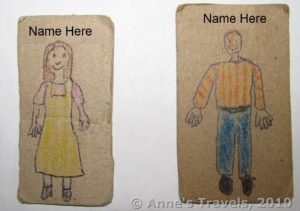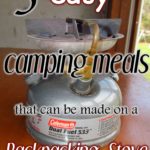There are any number of games that you can play with the paper dolls, and the children keep coming up with new ones each trip, so this won’t be an all-inclusive list. Use your imagination, and see what else you can come up with!
Our paper dolls are rectangles of cardboard (about 1½” x 3”) with a friend or family member drawn on each rectangle. Then, the children colored each person with crayons or colored pencils.
Here are some of the games that were popular on our last trip. I would like to thank my sister for patiently explaining each one to me (sometimes more than once) so that I can post them here.
Who’s Older?
This game is very much like the traditional face-card game of War, except that a card’s value is in the age of the person on that card. To play, the paper dolls are shuffled and then all of them are dealt to the players (2 players works best, but you can have as many as you want, with the player with the oldest paper doll getting the dolls from all of the other players). Each player puts their dolls into a stack, and then turns over the paper doll on the top of the stack. The player with the paper doll who has the oldest age takes the paper doll(s) with the younger age(s), and puts both in his/her lap. Play continues the same way, until one of the players runs out of cards. Then the players shuffle the cards in their laps and play continues. If two people of the same age are put down, the players have a “picnic”. The two dolls of the same age are placed on a book (or another flat surface), and the players each add 3 more paper dolls on top of their own initial paper doll, saying “It’s Pic-nic” and add a 5th and final doll to the pile saying, “Time”. (In other words, instead of “I De-clare War” it’s “It’s Pic-nic Time”.) The player with the highest-aged doll on top of their stack wins all of the paper dolls on the book. Eventually, someone is supposed to run out of paper dolls, and the player with all of the paper dolls wins, but this can take some time!
Do You Know…?
Because not all of the people on our paper dolls know each other in real life, it gives us an opportunity to play a game based on if the people know each other. It is a solitaire game. First, shuffle all of the paper dolls, and stack them, or put them in a zip-lock bag (our favorite way to store them). Take out the first paper doll and put him or her on the upper left-hand part of a book that is sitting in your lap. Next, take another paper doll and figure out if the person on the book knows the person that you just picked up. If they know each other (usually we say, “If they’ve met, then they know each other”), then put the new paper doll on top of the one on the book. If they don’t know each other, place the new doll just to the right of the one that’s already on the book. Pick up another card, and see if this person knows the person on top of the first pile of paper dolls. If not, do they know the person on top of the second pile of paper dolls? Play continues in this way until all of the paper dolls are used up. Then we see if the person on the bottom of the last pile of paper dolls knows the person on the top of the second-to-last pile of paper dolls. This continues backwards along the piles until the person on the bottom of a stack doesn’t know the person on the top of the next-back stack. The goal is to see how few piles you have left at the end of the game.
Hair, Eyes, Shirt, Pants, Shoes
Randomly pick 5 paper dolls (a good way to do this is to have all of the paper dolls in a bag, and you can just reach in and pick out 5 paper dolls). Look at the first paper doll’s hair color. Any of the other 4 paper dolls who have this same hair color are saved out; the rest are out of the game. If none of the paper dolls have the same color hair as the first paper doll, all of the paper dolls, including the first one, are out of the game. Set aside the ones with the matching hair color, and pick 5 more paper dolls (out of the bag). With these, the paper dolls that are saved out must match the first one’s eye color. The ones who don’t match are out of the game, the ones that do are set aside. Again, if none of the other 4 paper dolls match the first one, all 5 are out of the game. Continue playing in this way using shirt color, pants/shorts/skirt color, and shoe color, and then hair color and eye color again until all of the paper dolls are either set aside or out of the game. Next, take all of the dolls that were set aside and play with these until only one or a few paper dolls are left. This/These paper doll(s) win(s) the game.
Produce a Play
Sometimes the children will take a book (usually a picture book, although longer chapter books work as well) and produce a “play” using the story. Each actor or actress is randomly selected (for example, if they are producing a play about Goldilocks and the Three Bears, paper dolls will be pulled randomly until a girl between 2 and 13 is chosen. That girl gets to play Goldilocks). After some of the paper dolls are given the parts of each of the different characters in the story, the other paper dolls are chosen to act as director, assistant director, light man, sound engineer, stage prop coordinator, costume designers, etc, even to having musicians for the show. The rest of the paper dolls get to be the audience. The children don’t always act out the play itself, but it’s quite fun to see who gets to play which part, or if the parts given to each paper doll go with their actual personalities. For example, if an uncle who’s tone deaf gets the position of band leader…!!!
Conversation
Another game the children all enjoy is to make up crazy sentences and then randomly pick a paper doll who supposedly says that sentence. Sometimes it makes quite a bit of sense that this particular person would say something like that, but other times it’s quite funny, and the person would never say something like that. An illustration might be: ‘Let’s go to the top of a really high cliff and look over the edge,’ said… a cousin who’s terribly afraid of heights.
“He Drives a…”
This is a game that can be played with the help of picture books. In general, the book should have pictures or illustrations of trucks, cars, and/or construction vehicles in it (a favorite with our little boys). Open the book to the first page with a picture of a vehicle on it, and then randomly pick a paper doll. The doll is driving this vehicle. This may not sound too interesting, but it can be hysterically funny when, for example, Grandma is driving a backhoe or Great Aunt Eleanora is riding a fancy motorcycle.
20 (or more) Questions
To play this game, one child randomly picks a paper doll, but doesn’t let the others see who the paper doll is. Then, the other players have to ask questions and see if they can guess what paper doll the child chose. Some questions, such as, “Does this person have blond hair?” make sense, and can really help to figure out who the paper doll is, while others, such as, “Does this person like applesauce?” may or may not be helpful in discovering the paper doll’s identity.
Go Fish
Basically, this is the traditional game of go fish, but each match is made up of members of the same family. For example, let’s say you made paper dolls of your friends, the Browns. There is a father, Matt, a mother, Jane, a son, Jonny, and a daughter, Suzy. Each of the players is dealt 5 (or 7) cards, and the rest are placed in a pile (in some way so they won’t fall all over the place—one person might want to be in charge of keeping the pile). Player 1 has Jane in his hand, and asks player 2 if she has a Brown. Player 2 has Jonny, so she gives that paper doll to Player 1, and he has a match. Player 1 could also have gotten Matt or Suzy as a match for Jane, because they are all members of the same family. If Player 2 hadn’t had any of the Browns, Player 1 would have had to pick up from the pile, and it would have been Player 2’s turn to ask. If the card he had picked up had been a Brown, he could have asked again. (You’ll have to remove one person from each family that has an odd number of people in it. We say that these people are fixing dinner for the people who are playing.)
Uno
The game of Uno is basically played like the traditional game, with family members, ages, and first names matching up. Randomly deal 5 (or 7) paper dolls to each player, and lay one paper doll face-up on a book or other hard surface (just so the paper dolls don’t go falling everywhere). The rest of the paper dolls are laid face-down on the book. The first player can play any card in his/her hand on the face-up pile as long as the card matches the pile’s top card paper doll’s last name (in other words, is a family member of the person on the paper doll), is of the same age group, and/or has the same first name as the paper doll on top of the face-up pile. (The age ranges we typically play with are 0-25, 26-30, 31-40, 41-50, and 50+.) If the player doesn’t have a card in his/her hand that matches the card on the top of the face-up pile, s/he can pick up a card from the face-down pile. If s/he can play the card on the face-up pile, s/he may; if not, that player’s turn is over and the play passes to the next player. Play continues around to all of the players until one player is out of cards. However, when a player puts down his/her second-to-last card (in other words, leaving one card in his/her hand), the player must say “Uno”. If the player forgets, and one of the other players reminds him/her, the player who forgot to say “Uno” must pick up 2 more cards from the face-down pile. If the face-down pile runs out, take all but the top card from the face-up pile, shuffle the paper dolls, and make a new face-down pile.
We have also made Paper Doll Houses out of old cereal boxes (open up the box, and then draw the house on the cardboard inside). However, the design doesn’t have to be limited to a house. We’ve made an airport, a railroad station, a national park, the Statue of Liberty and Ellis Island (NYC harbor), a solar system, a restaurant, a gas station, a rest area… the possibilities are endless.
Sometimes the children will come up with all kinds of jobs or activities that the paper dolls could do inside of one of the houses. For example, someone might be making supper in the house, taking orders in the restaurant, driving the space ship in the solar system, or cleaning the rest area. Then, they randomly pick paper dolls to do each of the jobs. Sometimes, the people on the paper dolls are too young to do a certain job (you wouldn’t want an 18-month-old making soup on his own), so two people must do the job together, an older one to help the younger one.
These are just more ways that the children keep themselves occupied while we’re driving. I’ve known some children who can play these and other games for hours, while others couldn’t be bothered with them. So, you’ll just have to find what works for you.
Bonus Game: Pit
The point of the game is to make sets made up of family members Make sure each family is complete before beginning – it isn’t fun to go all the way through the game and then realize the family you’ve been trying to reunite for what seems like hours actually had one person missing the entire time. If a person is single – say, a grandparent with their spouse deceased – this person is a set to themselves and anyone who gets this one person can tuck it away as a set.
Deal the number of paper dolls to each person as is in the largest family. For example, the largest family in our paper doll collection has 10 people, so each player is dealt 10 cards. If all your families are fairly small, deal 8 cards to each player; 5 cards if playing with younger children. Each player must now look at their hands and see if there are any sets – entire families – in their hand. Usually a family unit includes the parents and children, unless the children are on their own; decide before you start what constitutes a family in this game. For us, a family is the parent(s) and their children living at home (and any pets); a couple with no children living at home (or who don’t have children); and any single people who are a set to themselves (see above). Sets are set aside (usually in the person’s lap, one way or another) and are out of the game.
Once everyone has removed all the completed sets for their hand, play commences. Players choose however many cards they want to trade with another player – say, three cards – and begin repeating that number over and over until someone agrees to trade with them (“three-three-three-three-three…”) The trade must be with the same number of cards; if one player wants to trade three cards, the other player must also be trading with three cards. If no one appears to be interested in a trade, the player can replace the cards in their hand and choose different cards or a different number of cards to trade. (Note: cards traded at the same time must be of the same set. In our example, all three cards must be from the same family. However, a player with five family members in their hand can choose to only trade two of the family members – they simply must be from the same family.)
Whenever a player receives cards in his or her hand that completes a set, that person removes the set from his or her hand and sets them aside. If the player runs out of cards (through completing sets) the player draws additional cards that were left over when the initial cards were dealt (the player draws the same number that were originally dealt – for us, 10 cards). Play then continues.
If it becomes apparent that no more sets can be made with the cards in the players’ hands, each person can be dealt another two cards from the not-yet-dealt cards. Play continues as normal.
When all the cards have been dealt, play continues until all the sets are made, or until it is determined that the final set(s) cannot be completed (usually due to the last two cards being held by two different people; they could continue trading back and forth all day, but it simply isn’t worth it). The players then count the number of sets they completed. The player with the most sets wins the game (and therefore has the honor of putting away all the paper dolls!!!)
This Week’s Featured Product!
Looking for more games you can play on the road? Check out this book?








